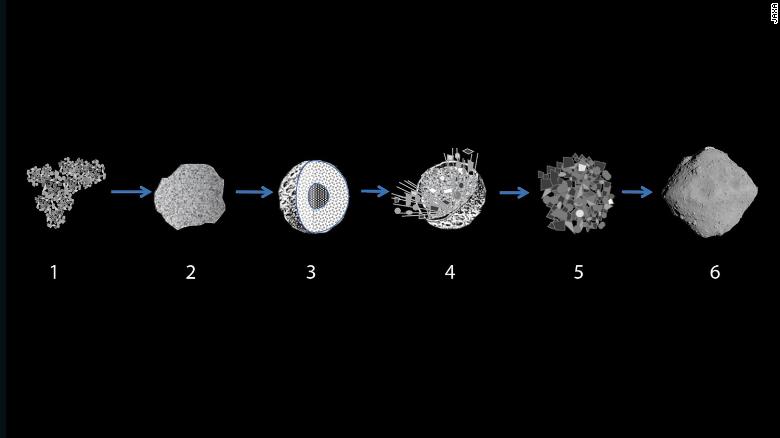- Click to share on Facebook (Opens in a new window)
- Click to share on Twitter (Opens in a new window)
- Click to share on LinkedIn (Opens in a new window)
- Click to email a friend (Opens in a new window)
The deadly asteroid that couldn't cope with bacteria 0:34
(CNN) - The Hayabusa2 spacecraft, from the Japan Aerospace Exploration Agency, fired a copper cannonball slightly larger than a tennis ball at a near-Earth asteroid named Ryugu, to learn its composition.
Nearly a year later, scientists have had the opportunity to analyze the data, captured by the spacecraft's cameras, to learn more about this asteroid, some 313 million kilometers away.
The Hayabusa2 probe deployed a small hand-held impactor, a device packed with plastic explosives, intended to blow up an artificial crater on the asteroid.
After deploying the impactor from the asteroid's orbit, Hayabusa2 moved a safe distance from the site of the explosion, according to the Agency.
It also launched a small camera called DCAM3 to capture the detonation as it occurred. The camera floated 0.8 kilometers away.
The researchers now know that the impact created a crater nearly 10 meters wide on the asteroid's surface, according to a new study. He sent a column of material on impact, which the camera was able to capture in detail.
The study was published in the journal Science on Thursday. A further study on the composition of the asteroid was published Monday in the journal Nature .
Capture the video with the images recorded by Hayabusa 2.
The crater left behind is like a semicircle, including a raised rim, a central hole, and an asymmetric pattern of ejected material, according to the researchers. They believe that the asymmetric pattern could be due to a larger rock below the crater.
Based on the material released by the impact, researchers also believe that the Ryugu includes material similar to loose sand on Earth.
The ejection curtain, or column of material created by the impact, never completely separated from the surface, according to the study. The researchers think this was due to the gravity of the asteroid.
Ryugu is a dark top-shaped asteroid that is approximately 900 kilometers wide. The surface is covered with rocks. It is also incredibly dry.
LEE: A large asteroid will pass close to Earth in April, but we will not impact, according to NASA
Photos captured by the spacecraft have revealed a uniform distribution of dark, rough rocks, as well as those that are shiny and smooth. Scientists believe there are two types of material on the asteroid because it probably formed from the debris left over after its parent body was hit.
Model of how the Ryugu was possibly formed.
The rocks are similar to carbonaceous chondrites, which are primitive meteorites. Some of the rocks contain small colored materials called inclusions that could contain minerals such as olivine. This is also found in carbonaceous chondrites.
The researchers in the Nature study also determined that the asteroid is largely made up of highly porous material. This could explain why carbon-rich meteorites are rarely found on Earth; our atmosphere protects them and makes them break into fragments.
Data was collected for study from the MASCOT lander during the mission, or the mobile asteroid surface SCOuT.
"Fragile and highly porous asteroids like Ryugu are probably the link in the evolution of cosmic dust in massive celestial bodies," said Matthias Grott, author of the study and an expert at the Planetary Research Institute of the German Aerospace Center. "This closes a gap in our understanding of planetary formation, as we have rarely been able to detect such material in meteorites found on Earth."
The researchers believe that it is possible that the highly porous structure of carbon-rich asteroids may be similar to planetesimals, or the material that eventually became planets in our solar system.
And asteroids, which act as remnants of the beginning of the solar system, could shed light on the early processes of the Solar System, such as how planets formed. Unfortunately, that's not something that astronomers have much direct evidence for. They can only build models based on what they know by studying the solar system and meteorites.
"Therefore, research on the subject depends primarily on extraterrestrial matter, which reaches Earth from the depths of the solar system in the form of meteorites," said Jörn Helbert, co-author of the study and director of research at the Planetary Research Institute. from the German Aerospace Center.
"Additionally, we need missions like the Hayabusa2 to visit the minor bodies that formed during the early stages of the solar system to confirm, supplement, or, with appropriate observations, refute the models."
READ : The asteroid that killed the dinosaurs favored bacteria
Hayabusa2 left Ryugu in December 2019 and will return to Earth in late 2020. It carries precious cargoes, including samples collected from two landing sites on the asteroid for analysis by scientists.
If it returns to Earth as scheduled, it will be the first mission to bring back samples of a Class C asteroid, which has not been visited before. Class C asteroids are the most common and comprise 75% of all known asteroids.
CNN's Euan McKirdy and Jack Guy contributed to this report.
Asteroid





/cloudfront-eu-central-1.images.arcpublishing.com/prisa/TQ73US57UFGWTIXR7C3BS2OTIA.jpg)


/cloudfront-eu-central-1.images.arcpublishing.com/prisa/XY3C6N54G4B3XBPGV7YLE3AUKM.jpg)



/cloudfront-eu-central-1.images.arcpublishing.com/prisa/KMEYMJKESBAZBE4MRBAM4TGHIQ.jpg)

